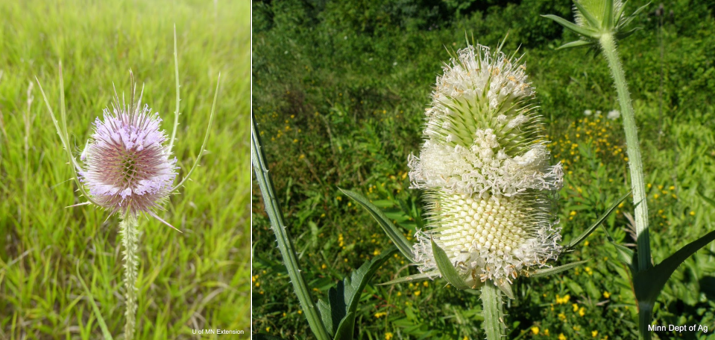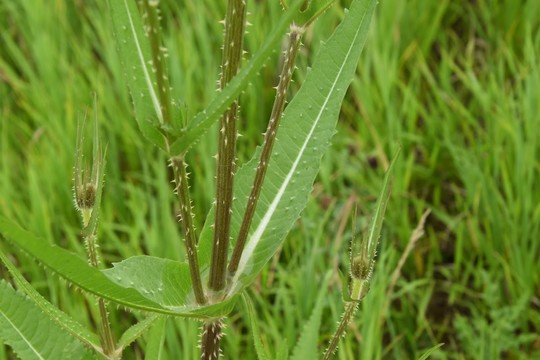|
Having trouble viewing this email? View it as a Web page.
May 31, 2022
June Weed of the Month: Teasel
Maggie Barnick, Minnesota Department of Agriculture
What is the connection between woolen mills and cemeteries? As you might have guessed, each of those has a connection to a noxious weed that has been reported in several new counties in Minnesota in the past several years. As early as the 1700s, teasel was brought from its native habitat in Europe to the United States. It is thought to have been grown for woolen mills to use in the process of “raising the nap,” or brushing out woven fabric to create a soft, uniform surface. Today, teasel can also be found in floral arrangements, and it can often be found in and around cemeteries where memorial bouquets contained dried teasel flowerheads.
 Common teasel flowers (left) are primarily purple in color. Outer bracts on their flowers extend beyond the head. Cutleaf teasel flowers (right) are white, with no outer bracts.
Click here to download the photo
Two species of teasel are currently found in Minnesota and both are Prohibited Eradicate Noxious Weeds, meaning all above and below parts of the plants must be destroyed. Additionally, no transportation, propagation, or sale of these plants are allowed.
Both species of teasel can form dense stands that shade out other species. Teasel is a monocarpic perennial, existing for at least one year as a basal rosette. Their rosettes can be rather large, with basal leaves as large at 16” in length at their full maturity. After at least one year, rosettes will have acquired enough resources to send up a prickly flower stalk. Teasel flowers along large oval-shaped heads from July to September, and their flower stalks can reach up to 7 feet in height. Flowers are tiny, blooming in rows on the heads, and are surrounded by spiny bracts. After teasel flowers, it produces seed and dies.
 Common teasel leaves and stems are prickly, and clasp the flower stalk, forming cups that can collect water.
Click here to download the photo
Common teasel has been reported 38 times in nine counties and cutleaf teasel has been reported 169 times in 17 counties. Most recently, cutleaf teasel was reported in Duluth. It is thought to have possibly escaped from a garden and then spread to adjacent public lands along the Munger Trail. It was also found across a busy street from its original location in Duluth. While its seeds typically don’t travel very far from the parent plant, it can be spread by humans or, in some instances, birds. Seeds germinate quickly and the seedbank is short lived, with most seeds germinating within 3-5 years.
If you suspect that you have found either type of teasel, report it! Be sure to include identifying characteristics in photos and record its exact location with either an address, or the location’s GPS coordinates.
You can report your find via EDDMapS or Report a Pest.
Find more information on identification of cutleaf teasel and common teasel.
MEDIA: For more information on Weed of the Month, contact Allen Sommerfeld, MDA Communications, at allen.sommerfeld@state.mn.us or 651-201-6185
|